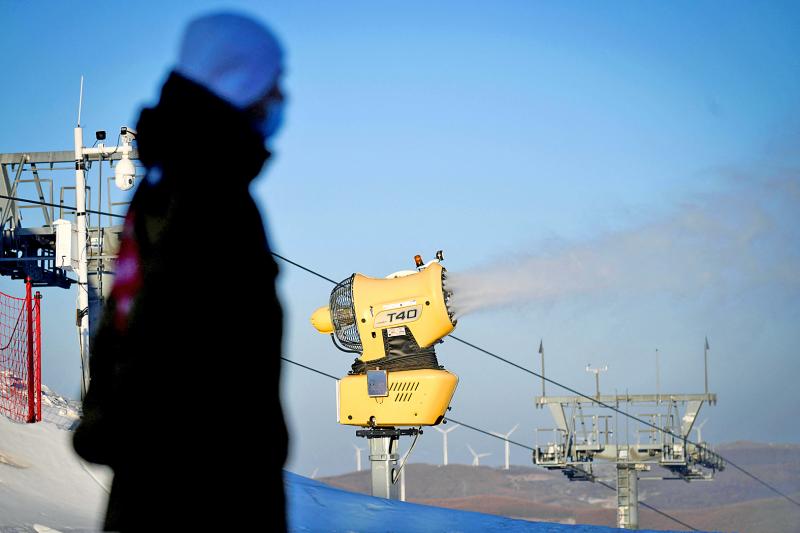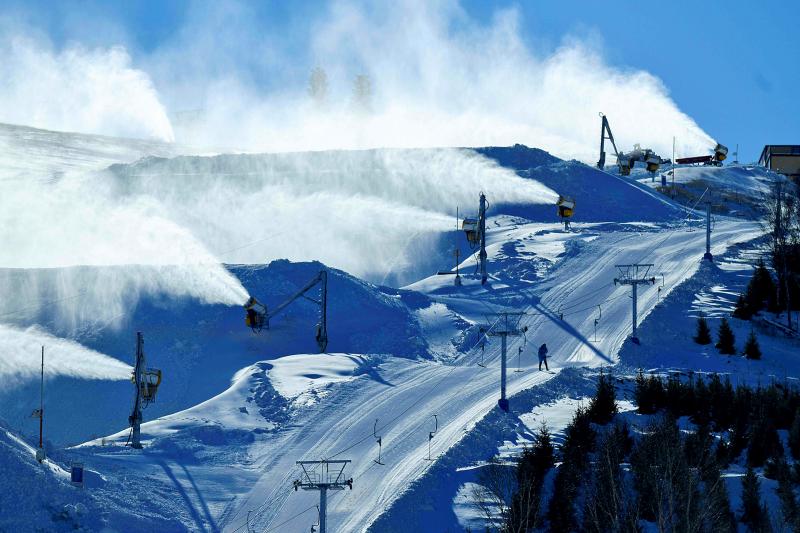Bright yellow turbines line the slopes of the Beijing Winter Olympics, spraying out the artificial snow needed for the Games to take place.
Man-made snow has been used to varying degrees since the 1980 Winter Olympics in Lake Placid, New York.
But February’s Beijing Games will depend almost entirely on artificial snow because they are happening in one of the driest parts of China.

Photo: AFP
With just five weeks until the Games begin, organizers are racing to coat the pistes in high-quality snow — a vast and complex task that critics say is environmentally unsustainable.
The venues use automated snow-making systems that monitor air temperature and humidity to maximize production.
Fed by local reservoirs, about 300 turbines — known as “snow guns” — mix water with compressed air before propelling the droplets into the air to form snow.

Photo: AFP
Workers then use truck-like vehicles called “snowcats” to spread the snow onto the pistes and sculpt jumps and turns.
Venues must ensure the snow meets precise standards of depth, hardness and consistency.
“The biggest challenge for us is maintaining uniform snow quality,” said Li Xin, deputy chief of mountain operations at the National Alpine Skiing Center in Yanqing (延慶), about 80km from Beijing.
Variations in the snow-making process “can cause snow quality to be too hard in some places and too soft in others, which could be dangerous for the athletes,” he told a press event at the site.
The stark white patches stand out vividly against Yanqing’s brown mountains, which see minimal natural snowfall. An International Olympic Committee evaluation report said that Zhangjiakou (張家口) and Yanqing — the Games zones hosting alpine skiing and snowboarding, among other outdoor events — “would rely completely on artificial snow.”
A 2020 study in science publication Nature warned that groundwater depletion in northern China was a “critical issue” and among the highest globally, due to intensive agricultural irrigation, rapid urbanization, and a dry climate.
This has meant water shortages for millions of Beijing residents and the water supply is likely to worsen in the future, researchers said.
Organizers at the Winter Olympics say the snow-makers are powered by renewable energy and will not damage mountain ecosystems, while the water they use will return to local reservoirs as the snow melts in spring.
The equipment’s automated systems reduce the kind of human error that can lead to wastage, said Florian Hajzeri, the China general manager for TechnoAlpin, the Italian company that supplies the machines.
With resorts worldwide turning to artificial snow to operate smoothly through the winter, “no matter which Olympics, there will always be snow-making systems for all of the venues,” he tsaid.
But experts say the reliance on man-made snow undermines Beijing’s pledge to hold a “green” Games.
Using large quantities of power and resources to create snow in the water-scarce region is “irresponsible”, said Carmen de Jong, a geography professor at France’s University of Strasbourg.
“We could just as well hold the Olympics on the moon or on Mars,” she said.

April 14 to April 20 In March 1947, Sising Katadrepan urged the government to drop the “high mountain people” (高山族) designation for Indigenous Taiwanese and refer to them as “Taiwan people” (台灣族). He considered the term derogatory, arguing that it made them sound like animals. The Taiwan Provincial Government agreed to stop using the term, stating that Indigenous Taiwanese suffered all sorts of discrimination and oppression under the Japanese and were forced to live in the mountains as outsiders to society. Now, under the new regime, they would be seen as equals, thus they should be henceforth

Last week, the the National Immigration Agency (NIA) told the legislature that more than 10,000 naturalized Taiwanese citizens from the People’s Republic of China (PRC) risked having their citizenship revoked if they failed to provide proof that they had renounced their Chinese household registration within the next three months. Renunciation is required under the Act Governing Relations Between the People of the Taiwan Area and the Mainland Area (臺灣地區與大陸地區人民關係條例), as amended in 2004, though it was only a legal requirement after 2000. Prior to that, it had been only an administrative requirement since the Nationality Act (國籍法) was established in

With over 80 works on display, this is Louise Bourgeois’ first solo show in Taiwan. Visitors are invited to traverse her world of love and hate, vengeance and acceptance, trauma and reconciliation. Dominating the entrance, the nine-foot-tall Crouching Spider (2003) greets visitors. The creature looms behind the glass facade, symbolic protector and gatekeeper to the intimate journey ahead. Bourgeois, best known for her giant spider sculptures, is one of the most influential artist of the twentieth century. Blending vulnerability and defiance through themes of sexuality, trauma and identity, her work reshaped the landscape of contemporary art with fearless honesty. “People are influenced by

The remains of this Japanese-era trail designed to protect the camphor industry make for a scenic day-hike, a fascinating overnight hike or a challenging multi-day adventure Maolin District (茂林) in Kaohsiung is well known for beautiful roadside scenery, waterfalls, the annual butterfly migration and indigenous culture. A lesser known but worthwhile destination here lies along the very top of the valley: the Liugui Security Path (六龜警備道). This relic of the Japanese era once isolated the Maolin valley from the outside world but now serves to draw tourists in. The path originally ran for about 50km, but not all of this trail is still easily walkable. The nicest section for a simple day hike is the heavily trafficked southern section above Maolin and Wanshan (萬山) villages. Remains of